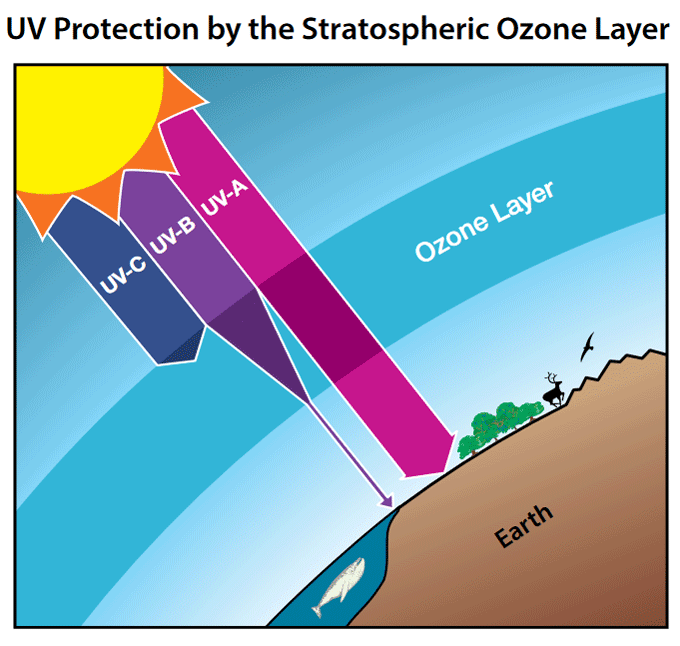Health and Environmental Effects of Ozone Layer Depletion
The AHEF model is used by EPA to evaluate human health effects associated with a depleted stratospheric ozone layer. An updated report published in May 2020 estimating UV radiation-induced health effects is available.
The Connection between Ozone Layer Depletion and UVB Radiation
Reduced ozone levels as a result of ozone depletionA chemical destruction of the stratospheric ozone layer beyond natural reactions. Stratospheric ozone is constantly being created and destroyed through natural cycles. Various ozone-depleting substances (ODS), however, accelerate the destruction processes, resulting in lower than normal ozone levels. The science page (http://www.epa.gov/ozone/science/index.html) offers much more detail on the science of ozone depletion. means less protection from the sun’s rays and more exposure to UVBA band of ultraviolet radiation with wavelengths from 280-320 nanometers produced by the Sun. UVB is a kind of ultraviolet light from the sun (and sun lamps) that has several harmful effects. UVB is particularly effective at damaging DNA. It is a cause of melanoma and other types of skin cancer. It has also been linked to damage to some materials, crops, and marine organisms. The ozone layer protects the Earth against most UVB coming from the sun. It is always important to protect oneself against UVB, even in the absence of ozone depletion, by wearing hats, sunglasses, and sunscreen. However, these precautions will become more important as ozone depletion worsens. NASA provides more information on their web site (http://www.nas.nasa.gov/About/Education/Ozone/radiation.html). radiation at the Earth’s surface. Studies have shown that in the Antarctic, the amount of UVB measured at the surface can double during the annual ozone hole.
Ozone layer depletion increases the amount of UVB that reaches the Earth’s surface. Laboratory and epidemiological studies demonstrate that UVB causes non-melanoma skin cancer and plays a major role in malignant melanoma development. Of the human health effects from sun exposure, melanoma is the most lethal, causing nearly 7,000 deaths annually in the United States. In addition, UVB has been linked to the development of cataracts, a clouding of the eye’s lens.
Effects on Human Health
Ozone layer depletion increases the amount of UVB that reaches the Earth’s surface. Laboratory and epidemiological studies demonstrate that UVB causes non-melanoma skin cancer and plays a major role in malignant melanoma development. In addition, UVB has been linked to the development of cataracts, a clouding of the eye’s lens.

Because all sunlight contains some UVB, even with normal stratospheric ozone levels it is always important to protect your skin and eyes from the sun. See a more detailed explanation of health effects linked to UVB exposure from the Centers for Disease Control and Prevention.
EPA uses the Atmospheric and Health Effects Framework (AHEF) model to estimate the human health benefits of stronger ozone layer protection. More specifically, it estimates the number of skin cancer and cataract cases and deaths from skin cancer in the United States that will be prevented by protecting the ozone layer, which results in a decrease of the UV radiation reaching Earth’s surface that causes these diseases. Updated information on the benefits of EPA’s efforts to address ozone layer depletion is available in a 2020 report, Updating the Atmospheric and Health Effects Framework Model: Stratospheric Ozone Protection and Human Health Benefits. The May 2020 report estimates that full implementation of the Montreal Protocol on Substances the Deplete the Ozone Layer is expected to prevent approximately 443 million cases of skin cancer, 2.3 million skin cancer deaths, and 63 million cases of cataracts for people in the United States born in the years 1890–2100.
Effects on Plants
UVB radiation affects the physiological and developmental processes of plants. Despite mechanisms to reduce or repair these effects and an ability to adapt to increased levels of UVB, plant growth can be directly affected by UVB radiation.
Indirect changes caused by UVB (such as changes in plant form, how nutrients are distributed within the plant, timing of developmental phases and secondary metabolism) may be equally or sometimes more important than damaging effects of UVB. These changes can have important implications for plant competitive balance, herbivory, plant diseases, and biogeochemical cycles.
Effects on Marine Ecosystems
Phytoplankton form the foundation of aquatic food webs. Phytoplankton productivity is limited to the euphotic zone, the upper layer of the water column in which there is sufficient sunlight to support net productivity. Exposure to solar UVB radiation has been shown to affect both orientation and motility in phytoplankton, resulting in reduced survival rates for these organisms. Scientists have demonstrated a direct reduction in phytoplankton production due to ozone depletion-related increases in UVB.
UVB radiation has been found to cause damage to early developmental stages of fish, shrimp, crab, amphibians, and other marine animals. The most severe effects are decreased reproductive capacity and impaired larval development. Small increases in UVB exposure could result in population reductions for small marine organisms with implications for the whole marine food chain.
Effects on Biogeochemical Cycles
Increases in UVB radiation could affect terrestrial and aquatic biogeochemical cycles, thus altering both sources and sinks of greenhouse and chemically important trace gases (e.g., carbon dioxide, carbon monoxide, carbonyl sulfide, ozone, and possibly other gases). These potential changes would contribute to biosphere-atmosphere feedbacks that mitigate or amplify the atmospheric concentrations of these gases.
Effects on Materials
Synthetic polymers, naturally occurring biopolymers, as well as some other materials of commercial interest are adversely affected by UVB radiation. Today's materials are somewhat protected from UVB by special additives. Yet, increases in UVB levels will accelerate their breakdown, limiting the length of time for which they are useful outdoors.
